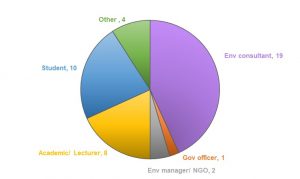ASIG Member’s Spring Questionnaire – The Results!
CIEEM Academic Special Interest Group
Spring 2020 Questionnaire
Thank you to everyone who participated in the Academic Special Interest Group (ASIG) questionnaire in February. The forty-four respondents represented the broad range of professions and roles which comprise our ASIG (Figure 1).

Figure 1. Current role of the questionnaire participants
Main reasons/ motivations for participants joining the ASIG
 Networking opportunities with academics/ researchers, practitioners and managers was identified as the main reason for joining the ASIG (Table 1) and scored high in responses from environmental consultants, academics/ lecturers, and students. While, access to monitoring and research data and research collaboration opportunities were also identified as reasons for joining, particularly by environmental consultants and students, the opportunity to improve/ influence student education/ training was the second scored reason for academic/ lecturers. Pertaining to this the ASIG committee recently hosted an online discussion and support session to share experiences and identify good practices as we adjust to delivering higher education courses during the COVID-19 situation. In addition, we are exploring further opportunities to implement activities that reflect the interests of members.
Networking opportunities with academics/ researchers, practitioners and managers was identified as the main reason for joining the ASIG (Table 1) and scored high in responses from environmental consultants, academics/ lecturers, and students. While, access to monitoring and research data and research collaboration opportunities were also identified as reasons for joining, particularly by environmental consultants and students, the opportunity to improve/ influence student education/ training was the second scored reason for academic/ lecturers. Pertaining to this the ASIG committee recently hosted an online discussion and support session to share experiences and identify good practices as we adjust to delivering higher education courses during the COVID-19 situation. In addition, we are exploring further opportunities to implement activities that reflect the interests of members.
Table 1. Main reasons/ motivations for participants joining the ASIG
| Rank | Score | Option |
| 1st | 4.03 | Networking opportunities with academics/ researchers, practitioners and managers |
| 2nd | 3.27 | Access to relevant monitoring and research data (e.g. journal articles, reports, case studies) |
| 3rd | 3.21 | Research collaboration opportunities |
| 4th | 2.84 | Opportunity to improve/ influence student education/ training |
| 5th | 2.00 | Access to teaching resources |
Preferred platform/s to facilitate communication and engagement within the ASIG
 Of the top four preferences to facilitate communication and engagement within the ASIG (Table 2) regular bulletins/ newsletters consistently scored highly across all professions. In relation to this, the ASIG committee’s first e-newsletter was launched in January 2020. We intend to issue newsletters tri-annually (January, May and September) to share information and stay connected. We welcome contributions from all ASIG members. We also contribute to In Practice, so look out for our articles and other information of interest including updates on the latest research, papers/ reports, and conferences.
Of the top four preferences to facilitate communication and engagement within the ASIG (Table 2) regular bulletins/ newsletters consistently scored highly across all professions. In relation to this, the ASIG committee’s first e-newsletter was launched in January 2020. We intend to issue newsletters tri-annually (January, May and September) to share information and stay connected. We welcome contributions from all ASIG members. We also contribute to In Practice, so look out for our articles and other information of interest including updates on the latest research, papers/ reports, and conferences.
Provision of workshops at regional and national meetings were the highest scoring response; however, this platform was preferred amongst academics/ lecturers and students, while environmental consultants had a stronger preference for webinars. Given the broad diversity of our members, the committee will use a range of platforms to communicate and engage within the ASIG.
Table 2. Preferred platform/s to facilitate communication and engagement within the ASIG
| Rank | Score | Option |
| 1st | 4.20 | Workshops at regional and national meetings |
| 2nd | 4.14 | Regular bulletins/ newsletters |
| 3rd | 3.94 | Articles in ‘In Practice’ |
| 4th | 3.58 | Webinars |
| 5th | 3.00 | Networking events |
| 6th | 2.23 | Social media |
Suggested role of ASIG for preparing students for the workplace and providing training
 Preparing students for the workplace is core to the academics role in the ASIG. The responses to this question were diverse and represented the diversity of the ASIG members. Broadly categorised, the responses included:
Preparing students for the workplace is core to the academics role in the ASIG. The responses to this question were diverse and represented the diversity of the ASIG members. Broadly categorised, the responses included:
- Connecting Research/ Practice/ Application,
- Types of training,
- Provision of guidance,
- Requirement for fieldwork,
- ASIG representation, and
- Developing competency.
We believe that this theme could be used as a topic for a workshop, to get environmental consultants, academics/ lecturers and other professions together, to discuss this important role.
Suggested research areas to be included in the ASIG’s 2020 agenda
 Regarding research areas participants would like to see included in ASIG’s 2020 agenda, there was a strong interest in connecting research and practical ecology which included a diverse range of suggested topics to be taken forward. Ranking second, was an interest in technical topics which included survey and assessment, mitigation/ habitat creation and restoration, which were associated with a range of specific species and habitat interest areas. This was followed by an interest in education and training. We are exploring options to address some of these responses including facilitating the connection of different people and interest areas, and better communication of latest research.
Regarding research areas participants would like to see included in ASIG’s 2020 agenda, there was a strong interest in connecting research and practical ecology which included a diverse range of suggested topics to be taken forward. Ranking second, was an interest in technical topics which included survey and assessment, mitigation/ habitat creation and restoration, which were associated with a range of specific species and habitat interest areas. This was followed by an interest in education and training. We are exploring options to address some of these responses including facilitating the connection of different people and interest areas, and better communication of latest research.
Thanks again for sharing your thoughts and ideas with us. Based on the data collected we will continue to explore options to develop future actions and opportunities within the ASIG. We welcome feedback and contributions from all members as we continue to build a strong Group.
Please email your thoughts to: membernetworks@CIEEM.Net
